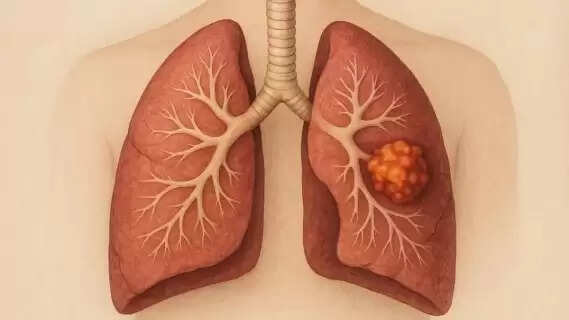
New Delhi: World Lung Cancer Day is observed on August 1 each year. The purpose of the day is to shed light on the issue of lung cancer, one of the most common types of cancer globally. Reports indicate that lung cancer saw 2.2 million new cases and 1.8 million deaths attributed to it in 2020. The foremost contributor to lung cancer is smoking, which accounts for 85% of all cases. However, there are several other factors, apart from smoking, that greatly increase the chances of developing lung cancer. Approximately 20% of lung cancers today are found in non-smokers. Below, doctors elaborate on the smoking-related causes of lung cancer. Radon Gas Exposure Radon- enriched gas is common in homes and poorly ventilated structures built on radon-rich soil and is the second-leading cause of lung cancer, smoking being the foremost, and the primary cause for non-smokers. As inhaled radon gas decays it releases radioactive substances that can over time harm lung tissue and cause cancer. Dr. Ankur Bahl, Senior Director- Medical Oncology at Fortis Gurgaon, states that it is the second leading cause of lung cancer after smoking; leading cause in non-smokers.Asbestos ExposureBreathing in asbestos fibers causes them to settle in the lungs, leading to inflammation, tissue scarring, and the development of malignant tumors, which may also result in mesothelioma (a rare cancer of the pleura). Dr. Bahl states that construction and shipyard workers, along with individuals residing in older buildings with crumbling asbestos, are at a greater risk of lung cancer due to asbestos exposure.Air Pollution Air pollution is composed of both outdoor and indoor pollution. It is one of the leading causes of lung cancer in non-smokers. Dr. Tirathram Kaushik, a Senior Consultant in GI, HPB, Gastrointestinal, and Thoracic Oncology and Robotic Surgery at the HCG Cancer Center in Borivali, and Dr. Bahl, an associated physician, share the experience of emerging urban, young and seemingly healthy individuals with early signs of the disease. What connects these individuals is the fact that they have been breathing for years the air in industrial areas, near highways, or construction sites. These locations have high concentrations of fine particulate matter, and hazardous gases such as nitrogen dioxide, ozone, and sulfur dioxide, which are byproducts of vehicle and industrial emissions, power plants, and wildfires. Moreover, household air pollution is also a risk factor for lung cancer. The practice of burning biomass fuels such as wood, coal, and dung for cooking or heating in rural India contributes to lung cancer. Moreover, passive smoking and the use of incense sticks or dhoop’s burning also contribute. The said particles lead to chronic inflammation along with oxidative stress that can ultimately lead to damage of the cellular DNA.Passive SmokingWomen, even without being active smokers, are at high risk due to second-hand smoking exposure. Inhaling fumes from smoking for long periods in a household where smoking is prevalent poses an almost identical cancer risk when compared to smoking. Occupational Hazards Dr. Pushpinder Gulia, Director – Surgical Oncology & Robotic Surgery at CK Birla Hospital, Gurugram, informs that factory workers, miners, and individuals exposed to diesel exhaust, silica dust, arsenic, chromium, nickel, cadmium, and even coal tars or chemical fumes are at a greater risk. The exposure to such toxic substances poses an increased risk of cellular damage and malignancy. Genetic Factors Dr. Kaushik informs that for non-smoking lung cancer, genetic factors account for only 10%. A strong family history of lung cancer or inherited mutations boosts the risk. A person with first-degree relatives, such as parents or siblings, who had lung cancer is at increased risk of the disease. Previous Radiation Therapy to the Chest Cancer survivors who were treated with radiation for Hodgkin’s lymphoma or breast cancer develop lung cancer at a higher rate, as radiation can damage the DNA in lung cells, increasing the risk of malignancy over the years.Lung Diseases (Chronic Inflammation and Scarring)Chronic damage to bodily tissue increases the likelihood of developing lung cancer. Pulmonary fibrosis, turberculosis scars, and sarcoidosis are a few examples of these. Such lung diseases can lead to scarring, inflammation, and the potential for genetic mutation and carcinogenesis.Diet and Lifestyle FactorsSmoking is more prominent, but an insufficient diet of fruits and vegetables, excessive alcohol, and high-fat and processed foods can also have an indirect link as well as cancerous risk factors. Antioxidants are not abundant in these foods, and these habits can also hinder the body’s ability to repair cells.Hormonal FactorsWomen who never smoked are suspected to have lung cancer growth estrogen possibly influencing, and in part explaining, the greater occurrence of the disease among women relative to men. This discrepancy among the sexes is partially due to women being non-smokers.Viral InfectionsHPV and EBV have been associated with lung tumors, but the precise link, if any, is not clear. Viral oncoproteins, which may be responsible for these tumors, are capable of provoking abnormal cell proliferation which could be the reason for lung cancer.

